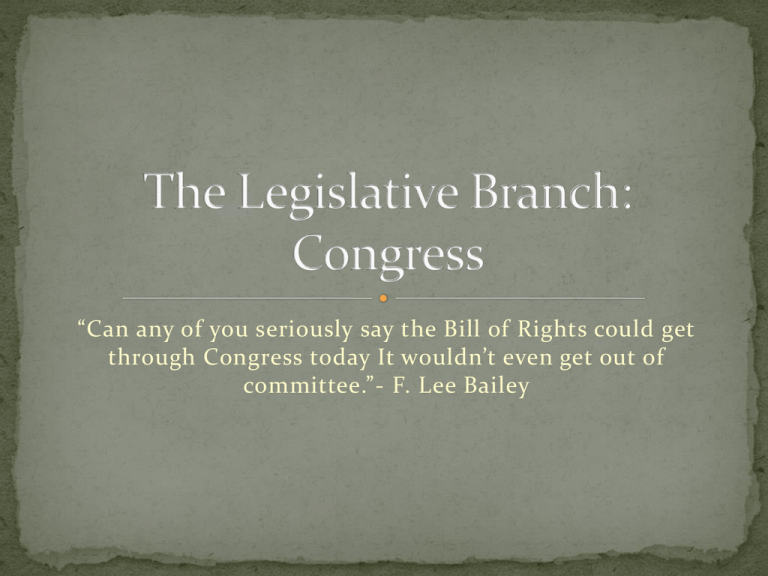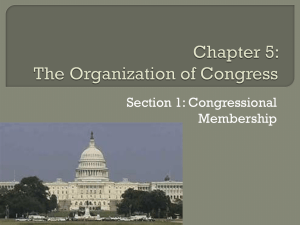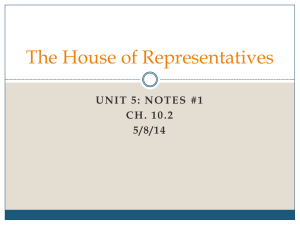The Legislative Branch: Congress
advertisement

“Can any of you seriously say the Bill of Rights could get through Congress today It wouldn’t even get out of committee.”- F. Lee Bailey “You see, in Washington they have these bodies, Senate and the House of Representatives. That is for the convenience of the visitors. If there is nothing funny happening in one, there is sure to be in the other, and in case one body passes a good bill, why, the other can see it in time and kill it.”- Will Rogers “They say women talk too much. If you have worked in Congress you know that the filibuster was invented by men.”- Clare Boothe Luce What are the qualifications to become a Senator? A Congressman/woman? How many Senators are there? How many Representatives are there? What compromise gave us the bicameral legislature? Congress is the legislative body, so they make the laws- Article I gives Congress its powers But Congress does other things……… Congress is the citizens’ link to the creation of public policy They represent the interests of constituents They oversee other governmental agencies (the federal bureaucracy) Powers found in Article 1 of the Constitution Bicameral- 2 house legislature Created partly out of history (England had one) and partly as a method of checks and balances (one house can effectively check the other) Term = 2 years 20th amendment changed start of term to be Jan. 3 of every odd numbered year Sessions = 2 sessions/ term; so 1 per year President can call special sessions any time 435 members (set by law in 1911 and officially capped in 1929) ** There are actually 441 reps. Because non-voting reps from D.C., Guam, U.S. Virgin Islands, American Somoa Representation determined by population (apportionment) Elected directly by the public Serve two-year terms with no term limit Power to begin all revenue bills Power to select the president if there is no electoral college majority Power to initiate impeachment proceedings Re-assignment of how many reps. Each state gets Done every 10 years after the census Census Bureau actually decides how many seats each state gets President has to send plan to Congress, who must approve it 1872 Law Elections held on Tuesday following the first Monday in November 1899 Voting machines used Off-year elections are elections that take place in a year without a presidential election Typically the party in power loses seats in off-year elections 435 members chosen by 435 districts States draw the boundaries for districts Most districts have one representative= single-member districts Districts drawn for the advantage of one party 2 methods: Concentrate opposition voters Spread opposition very thin Goal of gerrymandering is to create safe districts 1964- Wesbury v Sanders Supreme Court ruled that districts were too wide and unconstitutional “one person, one vote” Gomillion v Lightfoot- 1960 No race-based districts Race can be used to determine districts but cannot be a controlling factor 25 Citizen for at least 7 years Inhabitant of the state Framers wanted the Senate to be smaller and more enlightened, a kind of safe-guard against the popular will of the House Because they represent whole state, they have broader interests 100 Senators (2 from each state) Elected by public (17th amendment) Serve 6 year terms Power to approve presidential appointments Power to approve treaties Power to try impeachment proceedings Small enough not to need to give a group more authority No time limits on speaking, so more debate happens there Since they were not directly elected until 20th century, they were nominated by state legislatures and thus looking for ways to give back to leaders in the states Millionaire’s club by end of 19th century led to reform Filibuster common by end of 19th century Try to limit it by rule 22- which allows 60 senators to cut a debate off (cloture the debate) but unlimited debate is often used in senate 30 years old Citizen for at least 9 years Must live in the state he/she represents







